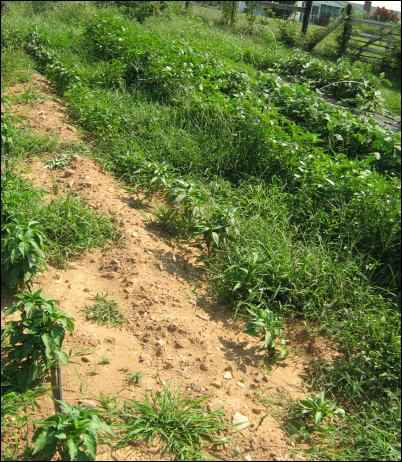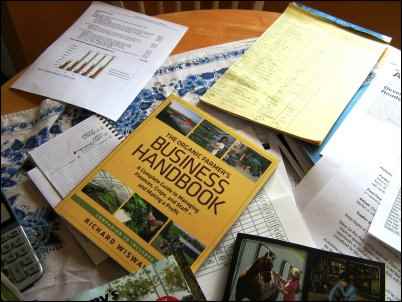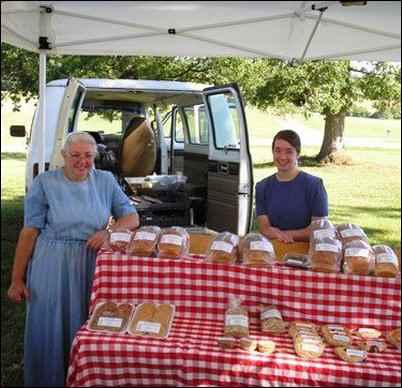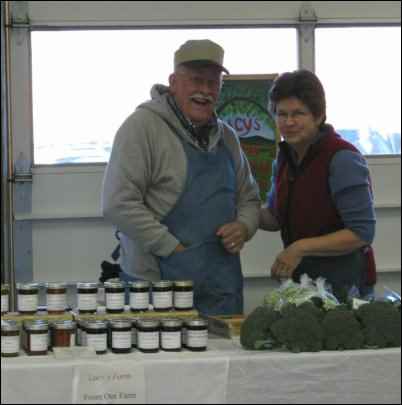When my husband and I ditched our rat-race city lives to lead a “simple” life in the country making a living off the land, the pictures on milk containers were about all we knew about farming. We bought five acres in the country, and now grow vegetables in about an acre of it and run pastured chickens (“meat birds”) on the other four. Though our bodies were past their primes, we felt as though the endorphins of newlywed life could carry us through any physical challenges. And because we didn’t have a tractor, or for that matter, any idea exactly what tractors did, there would be plenty of physical challenges.
We cajoled ourselves out of our denial of our naivety about all things rural by watching the complete DVD series of Green Acres. Oliver Wendell Douglas’ little speeches about farmers being the backbone of America still inspire me. Now a seasoned third-year farmer, well, a micro-farmer anyway, I can reflect back on those early days and appreciate that I, at least, have learned the basics.

Weeding should have been a given. I mean, everyone knows that to grow a successful crop, you have to keep the weeds down, right? We choose to grow organically, so herbicides aren’t really an option. Who knew you had to have a license for that stuff, anyway? We studied books with pretty pictures of tidy raised beds with even tidier straw-filled pathways. Mind you, these were gardening books… for serious, tidy, type-A gardeners who had as much time as they had money. They made it look easy.
So that first year, we tried our best to create some raised beds and sunken walkways. We filled the walkways with hardwood mulch. Within a couple of weeks, the plantain and burdock and dandelions were breaking through the mulch. Then came the wiregrass on top, underneath, and all around. We had failed to put down a ground cover beneath the mulch; because the dirt had looked so clean and weed-free when the mulch went down, we put the mulch on so thickly! By the second season, we had all but abandoned our raised bed approach.
Why? Because a nice man with a tractor and a plow had opened up a whole acre of our land for us to plant, and given us an acre of his third-generation-worked land down the road as well. Rows! We could plant in big, long rows, just like the big boys! And as for weeds, well, the tractor would take care of that with some sort of cultivator attachment on the satellite farm, and we could just ride our mower up the wide walkways on our land.

It was all well and good in April, May, and June. A little hoeing here, a little tractor cultivation there, a drive-by with the mower, and our little seedlings were well on their way to dominating the fields. Then July hit, along with the weed load. The crops were too big for the tractor to navigate through; too unwieldy for the mower to drive through without mowing the tomatoes down with the weeds. We ended up wading into a waist-high thicket of wiregrass, pokeweed, lamb’s quarters, and burdock to find our pepper plants. And tomatoes. And corn. And cucumbers. We tried to make a game of “find the watermelon,” but it was just too depressing to realize that 250 watermelon plants yielded about 100 watermelons due to our failure to make time for weeding in our grand farming plan. More often than not, we found them by tripping on them. Seriously.
So I learned one of the basics of farming: Weeding should not be an afterthought. Weed control is a critical part of an effective farm plan.
Speaking of farm planning, that’s where good record-keeping comes in. All my years in a desk job, I somehow managed to avoid having more than a passing acquaintance with Microsoft Excel, but this humble farmer now appreciates the value of a good spreadsheet. At least on paper, I get to see my crops in neat straight rows. Like President Eisenhower said, “Farming looks mighty easy when your plow is a pencil and you’re a thousand miles from the corn field.” Make that a computer and a few hundred feet and that’s me in January, abuzz with plans.
But that’s not where it ends: there are email lists to build; emails to send out to loyal and potential customers; flashy email newsletter programs to navigate and master; websites to design and write; facebook pages to create and update; listings on Find-a-farm websites to secure and update.
Then, of course, there are records to keep. Receipts must be categorized and entered for every purchase and every sale. The sales tax must be paid monthly at first, and then quarterly. Schedule F (F for farming?) must be filled out and filed with the IRS each year—Did you have any proceeds from crop insurance? Agricultural subsidy income? Lessee?

Let’s not even talk about the threatening letter from the USDA Census Bureau, which must have crossed in the mail with my completed 40-plus-page agricultural census. It seems everyone with a stick of ground and a shovel was required to participate in that one.
In sum, I had to find an awful lot of time for “paperwork”—and thank goodness for that, because it involved sitting down inside without feeling guilty—but it was all part of the job. Being a small farmer in the 21st century with a chance at “making it,” requires a high degree of literacy; computer and internet proficiency; and organizational skills.
Another thing I came to know was that I needed to make friends quickly. Farming friends. People who knew things about growing and selling things in our little county in central Virginia. I approached this task with forthrightness. I “got low,” with nary a high horse in sight, and admitted to everyone I encountered that I didn’t have a clue, and welcomed their suggestions and help. As it turns out, the cream does always rise to the top and the best people are the ones who appreciate the opportunity to help. Which is how we ended up befriending the best people in the county.
Our first stop—despite their reputation in some circles—before we even purchased land, was the county extension agent. It ended up being his advice that laid the foundation for what we consider our success. It was Brad Jarvis who told us we should do broiler chickens at the market, and it was Brad who steered us away from purchasing 25 acres with a run-down single-wide trailer and toward five acres with a solid, well-maintained home.
“I see a lot of people get excited about owning a lot of land. Then they have it and they think they have to do something with it. So they overextend themselves, and soon they’re in over their heads, and they don’t have the time or money to manage what they started and it’s a big mess… At the end of a long, hard day, where you don’t know if you’re gonna make any money or not that year, you want to come home to a place that won’t rattle when the wind blows,” he finished. Boy, was he ever right. We like our stick-frame house with its full, finished basement and the five acres is more than enough.
Brad made sure we got on the mailing list for every training event or workshop he knew of, and it was at one of these events that I landed my first off-season job. At a field day put on by various government agencies at a small, diversified, organic farm near us, I overheard the owner say she was looking for part-time, dependable farming help for the winter. I strode on over and raised my hand, “I’ll do it!” My husband ended up helping out there, too, that winter. So we both had off-farm jobs as farmhands that first winter.
We tended to chickens, dogs, donkeys, goats, sheep, and a cow first thing. Then we harvested salad and greens. Afternoons found us packing and washing produce; helping build a rustic outdoor hot tub out of bales of hay; moving stuff around with a tractor; preparing seed beds; and starting transplants. We learned a lot and stayed in shape for season two.
Brad was also instrumental in setting up the local farmers’ market, and I would have liked him for that alone. See, it was the Madison County Farmers’ Market that initially provided the fertile soil for this crazy farming idea to sprout. We came to love Madison County by way of friends who had a home there, complete with a view of the Blue Ridge mountains. They were very proud of the newly-established market in their little town, and if we happened to be there on a Saturday morning, it was off to the market we went.
I remember being star-struck seeing real live farmers at their booths. I didn’t even know such reverence for folks who worked the land was in me, but out it came. Why, there was Mrs. Mary Ruth Kipps, with her daughter, Catherine, laying out their fine assortment of baked goods on their red-checkered tablecloths. The Kipps had a dazzling assortment of multi-colored eggs, jars of jam, and pints of fresh berries and grapes to round out their offerings. Their homespun booth served as a kind of “anchor store” to the market.

When we had the opportunity to set up our booth next to the Kipps, we grabbed it, thrilled at our good fortune. Here we were, in only our second year, and we were next to the famous Kipps! Then, what really stunned us was when they asked us to be in charge of their booth for a few hours so they could attend a wedding. We had earned the trust and favor of the icons of the community. We imagined customers taking mental notes of how trustworthy and honorable we must be, and how our sales would flourish with our newfound status at the market.
Then there was Joel Yowell. I remember the first day I met him. Joel stood with his arms folded, his pick-up truck behind him, his free-range, non-GMO eggs stacked neatly in coolers, his giant garlic in bins on the table. He was the quintessential man of few words. My bubbly friend explained to him that I had an interest in farming, and I can only imagine what was going on behind his piercing gaze as he studied me while I babbled on about wanting to make a living growing vegetables and chickens… even though I had virtually no experience. Loathing, I assume. And yet, Joel and his wife welcomed us to the little community of vendors a few years later. One market day, I glanced over to see my husband, also a man of few words, standing next to Joel, the two of them striking up a friendship. I felt that old demon, pride, welling up. We were in!
However, perhaps no one screamed, “Farmer!” like the old-fashioned, handlebar-mustached, suspender-wearing, white-haired Max Lacy. He was full of good jokes, big hugs, and colorful idioms. It took me a few seasons to figure out that what he called “old-timey” onions were multiplier onions. Max and his wife lived in the same house—and farmed the same land—that once belonged to his grandfather. His sister lived two doors down, and his cousin in the house to the rear. I managed to get myself invited to a family gathering of sorts, and was surrounded by four generations of Lacys who seemed to have graciousness in their blood. Even the teenagers called me ma’am and shook my hand with no prompting!

So when Max sided up to us one day at the winter market and asked us if we wanted to use some of his good land to grow our crops next year while we got our land ready, we couldn’t have felt any more honored. No one but a Lacy had ever worked that land so far back as anyone could remember. To sweeten the deal, Max said he would do all the tractor work, and give us all the advice we wanted. Our very own mentor! I’m quite sure he regretted that decision once he saw the results of our non-existent weed management plan, but I still get the occasional hug and that’s good enough for me.
I could go on and on about the friends, neighbors, and farmers—most of the time they’re one in the same—who have helped cultivate our dream.
There are the Riders, who have a loyal following for their pastured beef. They took to telling our customers all about us, sending them over to see how delicious our “Cadillac Chickens” were.
Margaret Hutcheson, friend, cooperative CSA business partner, vegetable farmer, canner, and all around “good neighbor” in every sense of the word, deserves an article all her own. She even coaxed her husband into sharing their spreadsheet-style planting plan with us, so we could get a jumpstart on making our own. Just don’t ask them what kind of eggplant they grow. All farmers have their secrets!
While the farming community will always have a respectable place for the loners of the world, having some relationship skills can’t hurt. The more people who know what you’re about, what you need, and what you can do, the more likely you are to come across some wonderful opportunities.
Well, even though it’s only spring, that wiregrass is sprouting, and this year, I’m on it. Time to get to weeding.











Enjoyable read, Diana, and good advice about the benefits of getting involved in the community.